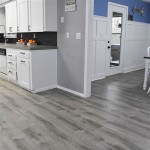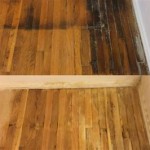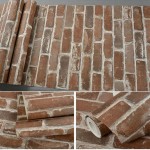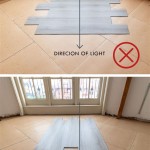Cross Cut Wood Flooring: A Detailed Examination
Cross cut wood flooring, also known as end grain flooring, represents a distinctive and durable option within the spectrum of wood flooring choices. Unlike traditional flooring where the wood grain runs parallel to the surface, cross cut flooring presents the end grain, effectively showcasing the tree's growth rings. This orientation provides several unique attributes that differentiate it from plank or parquet flooring.
The defining characteristic of cross cut flooring lies in its construction. Sections of wood are cut perpendicular to the tree's trunk, exposing the cellular structure of the wood. These sections are then typically assembled into tiles or blocks, creating a surface that is significantly more resilient to wear and tear when compared to conventional wood flooring. The visible growth rings contribute to the aesthetic appeal, offering a natural and textured look.
Historically, end grain wood has been utilized in industrial settings and factories due to its exceptional durability. The industrial aesthetic has gained popularity in residential and commercial spaces, leading to a resurgence of cross cut flooring's use in various areas. The material's ability to withstand heavy foot traffic and resist impact makes it suitable for high-use areas such as entryways, kitchens, and retail establishments.
Durability and Longevity
One of the prominent advantages of cross cut flooring is its inherent durability. The end grain structure provides a surface that can withstand significant pressure and impact. When force is applied, the cells of the wood compress and spring back to their original shape, unlike the linear grain of plank flooring which is more susceptible to splintering and denting. This property makes cross cut flooring a practical choice for areas that experience high foot traffic or are exposed to heavy objects.
Furthermore, the density of end grain wood contributes to its resistance to wear. The tightly packed cells create a robust surface that is less likely to show scratches, dents, or other signs of damage. This inherent strength translates into a longer lifespan compared to other flooring options, reducing replacement frequency and ultimately offering long-term cost savings.
The end grain structure also offers some inherent sound dampening properties. The wood cells absorb sound waves, reducing noise transmission between floors and rooms. While not as effective as specialized acoustic flooring, cross cut wood flooring can contribute to a quieter and more comfortable environment.
Aesthetic Considerations
Beyond its functional properties, cross cut wood flooring offers a unique aesthetic. The exposed growth rings create a distinct pattern that is both natural and visually interesting. Each tile or block displays a different arrangement of rings, resulting in a varied and organic appearance across the floor. This natural variation contributes to the flooring's character and makes it a focal point in any space.
The visual impact of cross cut flooring can range from rustic to contemporary, depending on the type of wood used and the finishing techniques applied. Different wood species offer varying grain patterns and color tones, allowing for a wide range of design possibilities. Light-colored woods such as maple or birch can create a bright and airy feel, while darker woods like walnut or oak offer a more sophisticated and traditional aesthetic. The finishing process, including staining and sealing, can further enhance the wood's natural beauty and protect it from moisture and wear.
The modular nature of cross cut flooring allows for creative installation patterns. Tiles or blocks can be arranged in various configurations, such as checkerboard patterns, linear layouts, or custom designs. This modularity provides flexibility in tailoring the flooring to specific design preferences and architectural styles. The ability to customize the layout adds a unique and personalized touch to the space.
Installation and Maintenance
The installation of cross cut wood flooring typically involves adhering the tiles or blocks to a subfloor using a suitable adhesive. The subfloor must be level and clean to ensure proper adhesion and prevent unevenness in the finished floor. A moisture barrier may also be necessary to protect the wood from moisture damage, particularly in areas with high humidity or concrete subfloors.
Grouting between the tiles or blocks is often required to fill any gaps and create a seamless surface. The grout material should be compatible with wood and resistant to staining and cracking. The choice of grout color can also influence the overall aesthetic of the floor, providing either a contrasting or complementary effect.
Proper maintenance is essential to preserving the appearance and longevity of cross cut wood flooring. Regular cleaning with a damp mop and a wood-friendly cleaner is recommended to remove dirt and debris. Avoid using harsh chemicals or abrasive cleaners, as they can damage the wood's surface. Periodic sealing or waxing may be necessary to protect the wood from moisture and maintain its luster. With proper care, cross cut wood flooring can retain its beauty and durability for many years.
Furthermore, consideration should be given to the type of wood used in cross cut flooring. Softer wood species may be more prone to dents and scratches, while hardwoods offer greater resistance to wear. The choice of wood should be based on the expected level of foot traffic and the desired aesthetic. Consulting with a flooring professional can help determine the most suitable wood species for a particular application.
Environmental considerations also play a role in the selection of cross cut wood flooring. Opting for sustainably harvested wood can help reduce the environmental impact of the flooring. Certifications such as the Forest Stewardship Council (FSC) ensure that the wood is sourced from responsibly managed forests. Choosing environmentally friendly adhesives and finishes can further minimize the flooring's environmental footprint.
The thermal properties of cross cut wood flooring can also be a factor in certain environments. Wood is a natural insulator, which can help regulate temperature and reduce energy consumption. The density of end grain wood contributes to its insulation properties, making it a comfortable flooring choice in both warm and cold climates. This natural insulation characteristic can contribute to energy savings.
In conclusion, cross cut wood flooring presents a unique combination of durability, aesthetic appeal, and practical benefits. Its inherent strength, distinct visual character, and ease of maintenance make it a suitable option for a wide range of residential and commercial applications. The selection of wood species, installation techniques, and maintenance practices all contribute to the flooring's long-term performance and appearance.

Diy Cross Cut Tree Slice Floors Outdoors Or In Log Decor Flooring Natural Building

Diy Cross Cut Tree Slice Floors Outdoors Or In Piso De Moedas Pisos Design Casa

Wood Cross Cut Floor Tiles Of Emerald Isle North Ina Coast Tripadvisor

Сross Cut Coswick Com

Go With The Grain Rustic Flooring Mountain Living

Cherry Rough Sawn Crosscut Wood Veneer Composite 6 X 8 No Back 1 40 032s

Wood Colours And Textures Flooring Company London

Wood Colours And Textures Flooring Company London

Wide Cross Sawn Oak Plank 189mm Engineered Real Wood Floor Wood4floors

Hjælmø Upcycled Brick Flooring A Gain
Related Posts








